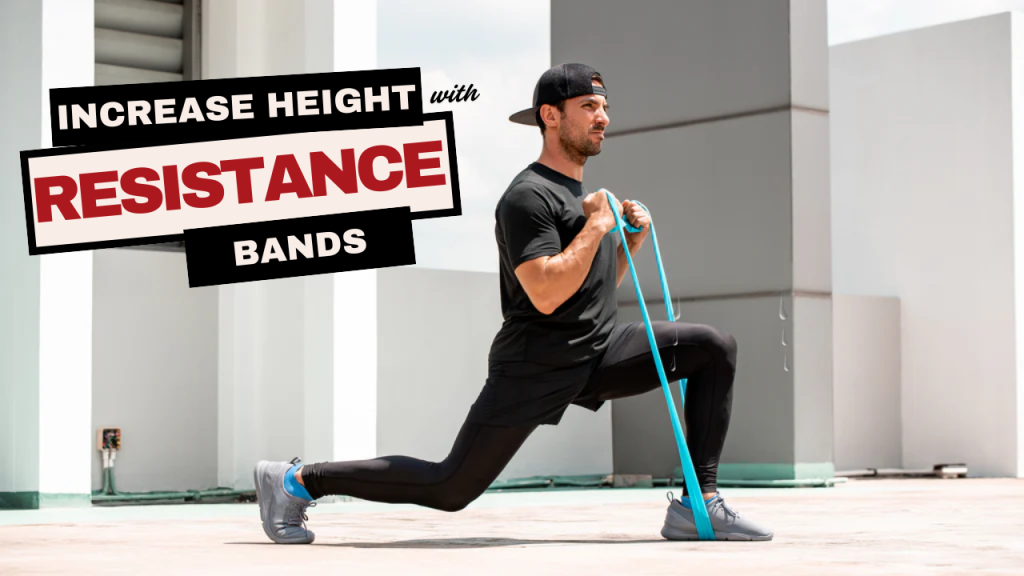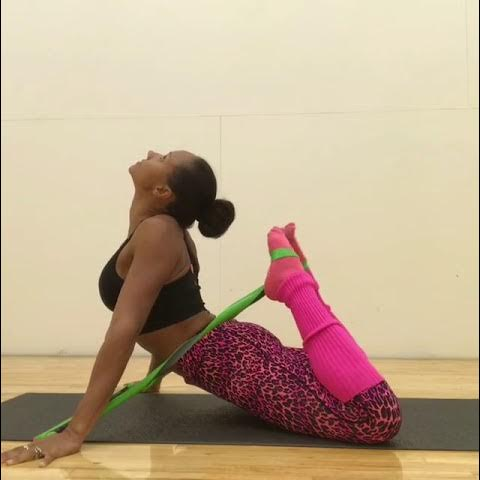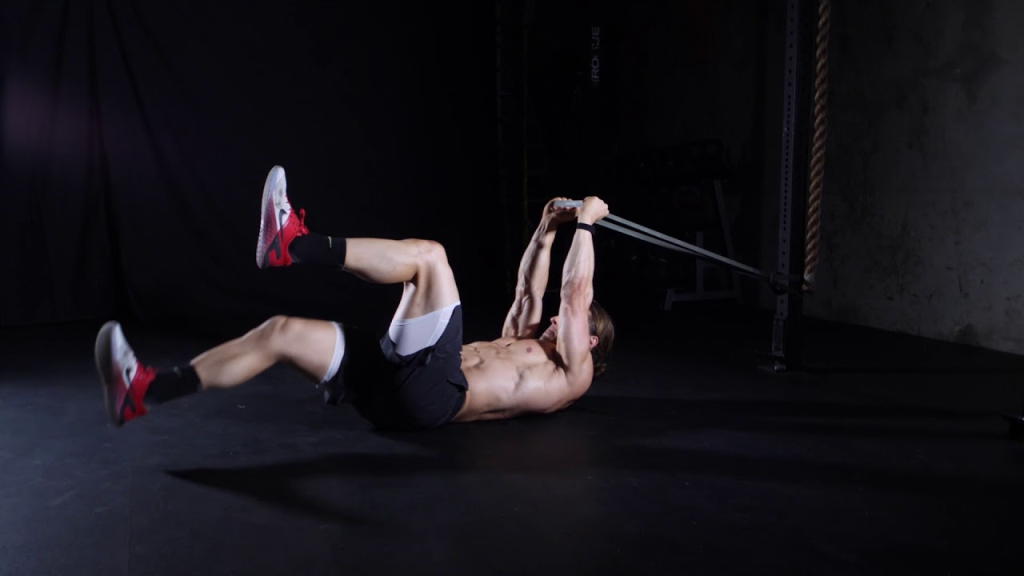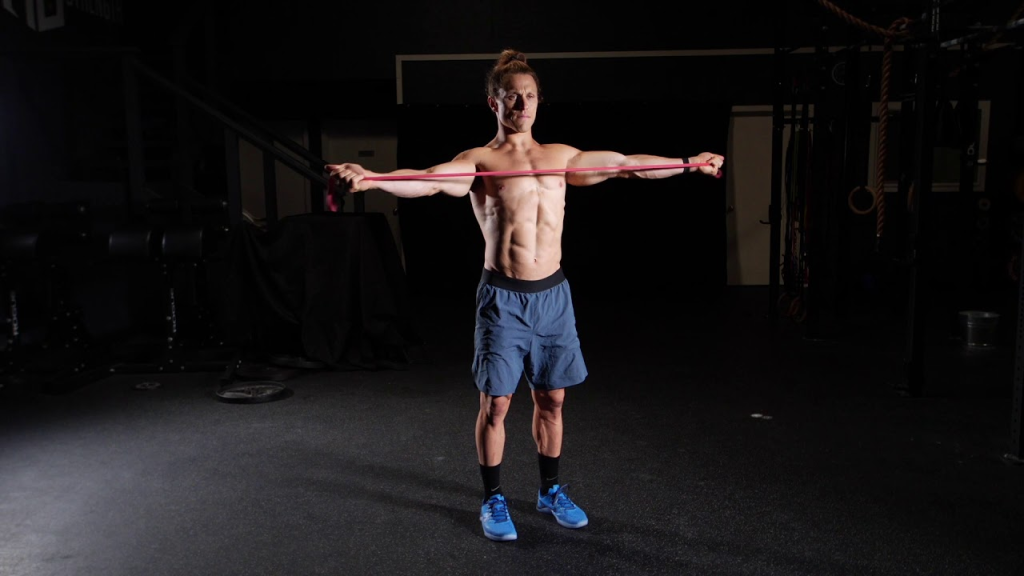“Can resistance bands really help you grow taller—or is that just another fitness myth?”
Here’s the truth: While you can’t drastically alter your genetic height, you can improve your posture, decompress the spine, and maximize your height potential with the right resistance band exercises. Think of it as unlocking the height you already have but might be hiding due to poor alignment and spinal compression. Resistance bands are a powerful, underrated tool in this process.
This guide dives into how to use resistance bands to appear taller, stand straighter, and stretch smarter—all backed by movement science.

Table of Contents
Perks of Using Resistance Bands to Increase Height
- Improves Posture
- Strengthens postural muscles and reduces slouching, making you look taller and more upright.
- Spinal Decompression
- Helps relieve pressure in the spine, which may restore lost height from compression.
- Enhances Flexibility
- Loosens tight muscles like the hamstrings, hip flexors, and shoulders that can limit upright posture.
- Strengthens Core & Back Muscles
- Supports better alignment and posture over time.
- Corrects Muscle Imbalances
- Targets weaker postural muscles to create better overall balance in the body.
- Safe & Low-Impact
- Perfect for daily use, even for beginners and teens, without straining joints.
- Portable & Convenient
- It can be used at home, at the gym, or while traveling—no bulky equipment is needed.
- Boosts Confidence
- Standing taller improves not just physical presence but also self-esteem.
- Complements Other Height-Boosting Methods
- Works well with yoga, Pilates, stretching routines, or inversion therapy.
- Supports Long-Term Spinal Health
- Promotes better mobility and reduces the risk of chronic back pain and poor alignment.
Do’s and Don’ts of These Exercise
| Do’s | Don’ts |
|---|---|
| Warm up before resistance band sessions | Skip warm-ups — cold muscles are more prone to injury |
| Focus on posture-improving exercises (e.g., pull-aparts, overhead stretches) | Only work on lower body — neglecting spine and posture muscles |
| Use light to medium resistance for stretching and mobility | Use overly heavy resistance that strains form or flexibility |
| Perform exercises consistently (4–5x a week) | Expect instant results — this is a long-term process |
| Combine band work with good posture habits and nutrition | Rely only on resistance bands without improving sleep or diet |
| Breathe deeply and hold stretches for at least 15–30 seconds | Rush through exercises without focusing on form |
| Target spinal, core, and hip flexor areas | Over-focus on arms or isolated body parts unrelated to posture |
| Maintain proper form to avoid injury | Perform exercises too quickly or with poor posture |
| Stay hydrated and rest when needed | Push through sharp pain or fatigue |
| Track your progress with photos or videos | Compare yourself harshly to others or expect growth beyond genetics |
Understanding Height & What’s Actually Possible
Before jumping into workouts, it’s important to understand what influences height:
- Genetics: Around 60–80% of your height is determined by genes.
- Environment & Lifestyle: Nutrition, physical activity, and sleep contribute significantly during growth years.
- Posture & Spinal Health: Slouched posture or compressed vertebrae can reduce your visible height by 1–2 inches or more.
Resistance bands help improve spinal alignment, stretch tight muscles, and strengthen postural support muscles. These small wins add up, making you look and feel taller.
Why Resistance Bands?
Resistance bands are portable, low-impact, and ideal for dynamic stretching and strengthening exercises. Here’s why they’re excellent for height improvement:
- Decompress the Spine: Bands assist in elongating the back and opening the spine.
- Correct Posture: Strengthen muscles like the traps, rhomboids, and erector spinae.
- Improve Flexibility: Stretching tight hip flexors, hamstrings, and shoulders promotes upright posture.
- Safe for Daily Use: Unlike heavy weights, bands reduce injury risk.
7 Resistance Band Exercises to Help You Maximize Height Potential
Note: Perform these exercises 4–5 times a week for best results. Always warm up before starting.
1. Overhead Band Stretch

Targets: Shoulders, lats, spine
How to do it:
- Stand tall, holding a resistance band overhead with a wide grip.
- Pull the band apart slowly while keeping your arms straight.
- Hold for 5 seconds, then release.
Reps: 10–12
This improves shoulder mobility and upper back posture, key to a taller stance.
2. Band-Assisted Cobra Stretch

Targets: Spine, abs, chest
How to do it:
- Lie on your stomach, loop the band under your hands.
- Push up into a cobra pose while pulling the band slightly apart.
- Hold for 10–15 seconds.
Reps: 5–8 holds
Encourages spinal extension and combats the hunching effect of sitting.
3. Resistance Band Dead Bug

Targets: Core, posture stabilizers
How to do it:
- Anchor a band above your head (like in a door).
- Lie on your back, holding the band handles.
- Extend opposite leg and arm, and return to center.
Reps: 10–15 per side
This strengthens the core muscles that support your spine alignment.
4. Band Pull-Aparts

Targets: Rear delts, traps, rhomboids
How to do it:
- Hold the band in front of you at shoulder height.
- Pull it apart until arms form a T.
Reps: 15–20
Builds upper back strength to correct rounded shoulders.
5. Standing Resistance Band Leg Stretch

Targets: Hamstrings, calves, lower back
How to do it:
- Anchor the band to a low point.
- Hook the band around one foot and pull the leg upward while standing or lying.
Reps: Hold 20 seconds per leg, repeat 2x
Tight hamstrings can pull the pelvis out of alignment—this stretch fixes that.
6. Resistance Band Hanging Rows
Targets: Lats, traps, spine support muscles
How to do it:
- Wrap the band around a solid anchor.
- Lean back and row the band toward your chest.
Reps: 10–12
Pulling movements help with spinal elongation and postural strength.
7. Band-Assisted Hip Flexor Stretch

Targets: Hip flexors, quads
How to do it:
- Anchor band behind you.
- Step one foot forward into a lunge, keeping an upright posture.
- Pull gently on the band for resistance.
Reps: Hold for 20–30 seconds each side
Lengthens the front of the body to allow for better posture.
1-Week Resistance Band Exercise Plan (Height-Focused)
| Day | Target Focus | Key Resistance Band Exercises |
|---|---|---|
| Day 1 – Monday | Spine & Posture | – Band Pull-Aparts – Overhead Band Stretch – Standing Back Extensions |
| Day 2 – Tuesday | Lower Body Flexibility | – Banded Hamstring Stretch – Hip Flexor Pulls – Lying Leg Raises with Band |
| Day 3 – Wednesday | Core & Upper Back | – Seated Rows with Band – Banded Dead Bug – Reverse Band Crunch |
| Day 4 – Thursday | Full Body Stretch | – Resistance Band Wall Angels – Side Bends with Band – Toe Touch Stretch with Band |
| Day 5 – Friday | Postural Strength | – Shoulder External Rotations – Good Mornings – Resistance Band Y-T-Ws |
| Day 6 – Saturday | Mobility & Recovery | – Dynamic Hip Openers – Cat-Cow with Band – Chest Stretch with Band |
| Day 7 – Sunday | Rest or Light Stretch | – Gentle Full Body Stretch – Deep Breathing with Shoulder Opener – Light Resistance Flow |
Tips:
- Do 2–3 sets of each movement, 10–15 reps or 20–30 seconds per stretch.
- Focus on form, breathing, and control—not speed.
- Mix in hanging, yoga, or swimming for added posture gains.
Tips to Enhance Results
To amplify your height-improvement efforts with resistance bands:
- Eat a height-supportive diet: Prioritize calcium, magnesium, zinc, and protein.
- Get 7–9 hours of quality sleep: Growth hormone is released during sleep.
- Incorporate yoga or Pilates: Both improve flexibility and spinal alignment.
- Avoid bad posture habits: Sitting for long hours? Use a lumbar cushion and take breaks.
The Bottom Line
While resistance bands won’t magically make you taller overnight, they’re a scientifically sound tool to:
- Stretch your spine,
- Correct poor posture,
- Strengthen key support muscles, and
- Help you stand up straighter—appearing up to 2 inches taller over time.
Consistency is key. Combine band exercises with healthy lifestyle habits, and you’ll unlock your full height potential—literally and visually.
Frequently Asked Questions (FAQs)
Can resistance bands actually help increase my height?
Resistance bands won’t change your bone structure or genetics, but they can help improve posture, stretch compressed spinal discs, and enhance muscle alignment—making you appear taller and stand straighter.
At what age can I start using resistance bands to improve height?
You can safely begin using resistance bands from the age of 13 and up. Teens and young adults still in their growth phase can benefit the most. However, adults can also use them to optimize posture and regain natural height lost due to poor alignment.
How often should I do resistance band exercises for better height?
Aim for 4 to 5 times a week, combining stretching, mobility, and strengthening movements. Consistency is more important than intensity for posture-based height improvements.
How long does it take to see results?
Most people notice improved posture and spinal flexibility within 3 to 4 weeks. Over time, this can make you look 1 to 2 inches taller, depending on your body’s condition and commitment level.
Can resistance bands help if I already have good posture?
Yes! Even if your posture is decent, resistance bands help maintain spinal health, prevent muscle imbalances, and ensure long-term upright posture—essential for maintaining your full height potential.
Is it safe to do resistance band exercises daily?
Yes, most resistance band stretches and mobility exercises are low-impact and safe for daily practice. Just listen to your body and allow rest if you feel sore or strained.
Which muscles should I focus on to appear taller?
Focus on core muscles, spinal erectors, shoulders, hamstrings, and hip flexors. These areas are key to upright posture, spinal decompression, and overall height visibility.
Can I combine resistance bands with other height-increasing methods?
Definitely. Combine them with yoga, hanging exercises, a nutrient-rich diet, and adequate sleep to maximize your height improvement efforts naturally and safely.





